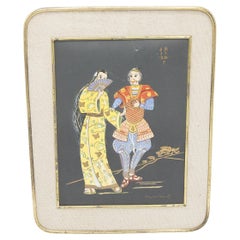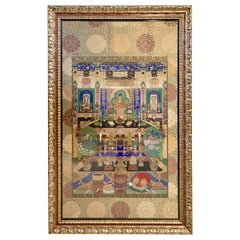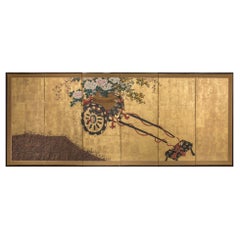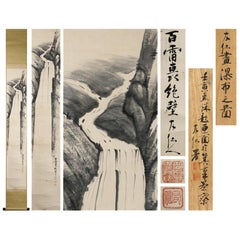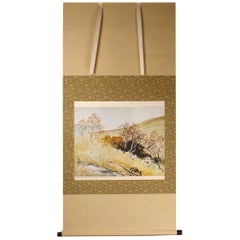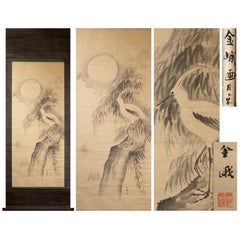Japanese Paintings and Screens
to
134
485
182
876
47
1
23
9
1
120
352
404
48
180
79
20
25
3
23
10
1
5
14
10
2
495
486
425
330
319
1,596
1,425
924
447
132
924
921
922
29
3
2
2
1
Place of Origin: Japanese
Antique Japanese Jute and Brass Painting 'First Date'
Located in Milano, IT
Ancient and very rare Japanese painting made in the early 1900s of fine Japanese manufacture. The painting has a rectangular brass frame, with rounded corners. Internally we see an a...
Category
Early 1900s Anglo-Japanese Antique Japanese Paintings and Screens
Materials
Brass
$380 Sale Price
20% Off
Large Framed Japanese Buddhist Amida Temple Hall Painting, Mid-19th Century
Located in Austin, TX
A large and incredible Japanese painting of a Buddhist temple hall with Amida Nyorai, late Edo or early Meiji period, mid-19th century, Japan. Mounted wit...
Category
Mid-19th Century Meiji Antique Japanese Paintings and Screens
Materials
Brocade, Silk, Acrylic, Wood, Paint
Japanese Six Panel Screen: Black and Gold Lacquer Flower Festival Cart
Located in Hudson, NY
Abundant flower arrangement of peonies in a basket, with a four legged rest to the right and a twig fence to the left. Fine lacquer ceremonial cart with silk ties and areas of raised...
Category
Early 19th Century Antique Japanese Paintings and Screens
Materials
Gold Leaf
Lovely Nihonga Scene Edo Period Scroll Japan Artist Yusen Okajima Japan
Located in Amsterdam, Noord Holland
It
is a work drawn by Yusen Okajima known as a Japanese painter of the Shijo school as you can see.
It is a waterfall map that makes you feel momentum from the top to the bottom, a...
Category
Early 19th Century Edo Antique Japanese Paintings and Screens
Materials
Silk
$997 Sale Price
20% Off
Autumn landscape 20th Century Scroll Painting Japan Artist Kawagoe Tamado
Located in Amsterdam, Noord Holland
It is a high-class craft of the work drawn by Kawagoe Tamado as you can see.
It is the "late autumn in the highlands" where you can feel the taste of autumn, and it is
a work in which the trees and flowers that sway in the wind shine well.
«Kawagoedado»
[1873-1957] Japanese painter. Born in Aichi.
His real name is Hosaburo. Another issue, Ikuan.
At the beginning, he studied under the Shijo school and then Masakuni Hashimoto to...
Category
Early 20th Century Taisho Japanese Paintings and Screens
Materials
Silk
$2,043 Sale Price
20% Off
Lovely Nihonga Scene Meiji/Edo Period Scroll Japan Artist Furuichi Kintome
Located in Amsterdam, Noord Holland
It is a work drawn by Furuichi Kintomi as you can see.
In addition to the fantastic depth of willow under the moon, the Egret
that shines in the night view is a truly delicious pie...
Category
19th Century Meiji Antique Japanese Paintings and Screens
Materials
Silk
$807 Sale Price
20% Off
Lovely Japanese 18th-19th Century Edo or Meiji Scroll Painting Japan
Located in Amsterdam, Noord Holland
Maruyama–Shijo style painting
C0ndition; Good but some stains.
Overall dimensions: width of about 28.2 cm and Length of about 173.8 cm
Painting width of about 25.5 cm × leng...
Category
19th Century Meiji Antique Japanese Paintings and Screens
Materials
Bronze
$665 Sale Price
20% Off
Farming Rice Fields Scene Meiji Period Scroll Japan 19c Artist Marked
Located in Amsterdam, Noord Holland
The simple country side life is the ideal of the Oriental scholar.
As you can see, the Kishi Renzan agricultural rice field working painting / box is included.
Agricultural rice fields are worked using horses...
Category
Mid-19th Century Meiji Antique Japanese Paintings and Screens
Materials
Silk
$1,187 Sale Price
20% Off
Vintage obi textile art "Under the Sun ~Serendipity " by ikasu Red / Beige Japan
By Kimono ikasu
Located in Setagaya City, JP
This artwork creatively uses tree bark to evoke the imagery of woods and mountains during both the morning and nighttime on left and right. It is elegantly framed with paulownia wood, a tree closely connected to kimono culture, and is filled with storytelling and sense of luxury.
By incorporating both the front and back sides of the same obi fabric woven in different colors, the play of light and shadow on the mountains is depicted through the contrasting appearances of these surfaces.
The intention behind this piece is to convey the exquisite beauty of Japanese mountains and the lush forests that inhabit them. To achieve this, traditional elements of Japanese culture, such as obi textiles and craftsmanship involving wood, were used.
The outer side and inner linings of the same obi, no longer suitable for clothing, along with bark material that would normally be discarded, have been repurposed to create this exceptional upcycle artwork.
The fusion of Japanese natural materials – silk, paulownia wood, and pine bark for the central decoration – along with the so-called "Tozan" pattern, a unique Japanese natural design showing mountains from far-away point, captures the magnificent beauty of Japanese nature from various perspectives.
The central bark decoration stands out as a distinctive feature of this work. Pine, oak, and other tree barks are interwoven among the mountains woven into the obi, creating a tangible and authentic natural atmosphere.
<< Period / Story >>
The obi used in this piece was originally crafted during the late Showa period (1960-80ies).
<< Explanation and meaning of pattern and colors >>
This upcycle artwork uses an obi with a tozan pattern woven in two colors. The design is inspired by a distant mountain range, a motif that has been used in paintings and crafts since ancient times. However, in this particular design, the mountains are depicted not as distant peaks but as graceful semicircles giving it a mild atmosphere.
<< Characteristics of the fabric >>
This upcycled Fukuro-obi (two-side obi) showcases a festive color pattern of mountains intricately woven with gold threads against a beige front and red on the back.
The way this obi interacts with light allows it to shift in expression, much like a mountain revealing different facets over time. It can transform from deep shades of color to the appearance of gold shimmering against bright hues, depending on the lighting and viewing angle.
<< About the frame >>
Kiritansu - chest-of-drawers for kimono, is traditionally made from paulownia wood, a uniquely Japanese material closely tied to the world of kimonos.
Paulownia wood is known as the lightest wood in Japan, prased for its natural luster, resistance to moisture, and resilience against cracking. Since ancient times, it has been used in crafting furniture, chests, and musical instruments.
During the Edo period, it became customary to store cherished kimonos in paulownia chests...
Category
Late 20th Century Japonisme Japanese Paintings and Screens
Materials
Silk, Wood
Scroll Painting Japanese 19th-20th Century Kōgyō Terasaki Meiji
Located in Amsterdam, Noord Holland
A fabulous landscape by Kogyo Terasaki
1866-1919
Japan painter. Akita prefecture production. Character is Tokusato, Soyama-Agaryunoki, beautiful poetry Yamabito, etc. to another is...
Category
20th Century Meiji Japanese Paintings and Screens
Materials
Bronze
$1,247 Sale Price
25% Off
Lovely Late Edo Period Scroll Paintings Japan Artist Landscape Painted
Located in Amsterdam, Noord Holland
Artist: "Hineno Taiyama"
End of the Edo period painter. Osaka production.
Hine Taizan (Hine Taizan, 10 years of culture (1813)-March 13, 1868 (April 24, 1869) is a literary painter...
Category
19th Century Edo Antique Japanese Paintings and Screens
Materials
Silk
$1,092 Sale Price
20% Off
Japanese Four-Panel Screen "Rimpa Painting of Pheasant on Old Plum in Garden"
Located in Hudson, NY
With raised twig fence and poultry cages (used for chicken, pheasants, etc). Wood vine on the fence, and some seasonal flowers in bloom. Delicately painted with wonderful colors and ...
Category
Early 19th Century Antique Japanese Paintings and Screens
Materials
Gold Leaf
Lovely 20th Araki Jippo Scroll Paintings Japan Artist Bird and Tree Painted
Located in Amsterdam, Noord Holland
"Araki jippo"
Japan painter.
Nagasaki prefecture production. First issue is Kinko. Name Teijiro.
Tokyo to study under Kanpo Araki, later it will be the Yoshishi.
You good at flow...
Category
Early 20th Century Edo Japanese Paintings and Screens
Materials
Silk
$1,092 Sale Price
20% Off
Scroll Kitsuda Eihô (1902 - 1974) Breaking of Dawn in the Mountains Japanese
Located in Amsterdam, Noord Holland
Kitsuda Eihô (1902 - 1974) Aanbreken van de dag in de bergen
Rolschildering / scroll op zijde, houten rollers, in houten cassette. Herkomst: Oranda Jin. B 128 x 41.9 / 202 x 56.3 cm...
Category
Mid-20th Century Meiji Japanese Paintings and Screens
Materials
Silk
$1,568 Sale Price
20% Off
Nightingale on Branch Meiji Period Scroll Japan 19/20c
Located in Amsterdam, Noord Holland
Very Lovely painting.
Category
Mid-19th Century Meiji Antique Japanese Paintings and Screens
Materials
Silk
$1,187 Sale Price
20% Off
Pair of Antique Japanese Flower Paintings by Yanagisawa Kien, circa 18th Century
By Yanagisawa Kien
Located in Prahran, Victoria
Pair of antique Japanese Nagasaki School paintings by Yanagisawa Kien (1704-1758), depicting classical ikebana flower arrangements. Each painted on silk in mineral pigments and beari...
Category
Mid-18th Century Edo Antique Japanese Paintings and Screens
Materials
Silk
Lovely 19th Tamazusa Kawabata Scroll Paintings Japan Artist Crane Painted
Located in Amsterdam, Noord Holland
Tamazusa Kawabata
1842-1913
Japan painter. Kyoto student. His name is Takinosuke, Keitei in another issue, and Kei in his later years. At the age of eleven, he entered the gate of Aki Nakajima, and later learned from Kaikei Oda. After moving to Tokyo, he learned oil painting with Yuichi Takahashi and Wargman. In addition, he became a modern Japanese Maruyama sect who loves Maruyama Okyo...
Category
19th Century Showa Antique Japanese Paintings and Screens
Materials
Silk
$2,993 Sale Price
20% Off
Grouping of Framed 19th and 20th Century Japanese Lacquer Panels
Located in Hudson, NY
The pair of panels are done in a fine gold lacquer with bone, mother of pearl & abalone shell inlays and where made in the mid 19th century. Most likely from a cabinet and retaining ...
Category
Late 19th Century Antique Japanese Paintings and Screens
Materials
Lacquer
Lovely 20th Yūki Somei Scroll Paintings Japan Artist Bird and tree Painted
Located in Amsterdam, Noord Holland
"Somei Yuki"
1875 (1875) - 1957 (1957)
Tokyo living, Japan painter.
Real name Sadamatsu, maiden name Morita.
Tamazusa Kawabata disciple, Tokyo art school graduation.
Empire Art ...
Category
Early 20th Century Edo Japanese Paintings and Screens
Materials
Silk
$1,092 Sale Price
20% Off
Lake Awasaru Scene Meiji Period Scroll Japan 19c Artist Marked Nihonga Style
Located in Amsterdam, Noord Holland
As you can see, it is a Japanese painting "Lake Suwa Asaharu" figure / co-box.
It is a "Lake Suwa Asaharu" figure with gentle sunlight, and it is
a very tasty work combined with a ...
Category
Mid-19th Century Meiji Antique Japanese Paintings and Screens
Materials
Silk
$1,187 Sale Price
20% Off
Lovely 20th Century Tatehiko Kan Scroll Paintings Japan Artist Crane Painted
Located in Amsterdam, Noord Holland
Tatehiko Kan
1878-1968
Tottori Prefecture born
real name: FujiTaro Sugawara
issue: Moritora, Shizuko, Tatehiko
Japan Art Academy Imperial Award, Osaka Art Association member, Os...
Category
19th Century Showa Antique Japanese Paintings and Screens
Materials
Silk
$2,993 Sale Price
20% Off
Lovely 20th Century Scroll Paintings Japan Tomobako Showa Artist Kobayashi
Located in Amsterdam, Noord Holland
Great decorated piece, artist Kobayashi Futoshi Gensho (B.1938-now)
Condition:
Very good. Size: Axis, vertical 117 cm horizontal 60.5 cm, painting, vertical 35 cm horizontal 58.5...
Category
20th Century Showa Japanese Paintings and Screens
Materials
Fabric
$1,202 Sale Price
25% Off
Meiji Chrysanthemum Masterpiece
Located in Fukuoka, JP
Step into a world of timeless beauty with our exceptional six-panel screen from the Edo-Meiji period. In impeccable condition, each panel features stunning paintings of chrysanthemum...
Category
19th Century Meiji Antique Japanese Paintings and Screens
Materials
Gold
Lovely Scroll Paintings Japan Artist Signed Wakasa Seigyo Monogai "Spring Breeze
Located in Amsterdam, Noord Holland
Wakasa Seigyo "spring breeze garden view", silk, colors, painting, hanging scroll, with box
Size: Axis, vertical 142 cm horizontal 65.5 cm
picture, vertical 44 cm horizontal 50.5...
Category
20th Century Showa Japanese Paintings and Screens
Materials
Silk
$1,024 Sale Price
25% Off
Fabulous Landscape by Kōgyō Terasaki 1866-1919 Japan Painter Akita Prefecture
Located in Amsterdam, Noord Holland
Maruyama–Shijo style painting
Condition; Good but some stains.
Overall dimensions: width of about 28.2 cm and Length of about 173.8 cm
Painting width of about 25.5 cm × leng...
Category
19th Century Meiji Antique Japanese Paintings and Screens
Materials
Bronze
$1,140 Sale Price
20% Off
Showa Period Jinmaku Screen
Located in Fukuoka, JP
Showa Jinmaku Screen
Period: Showa
Size: 376x171 cm
SKU: PTA116
Discover the historical charm of our Showa Jinmaku screen, impeccably preserved and in extremely good condition. Jinm...
Category
20th Century Showa Japanese Paintings and Screens
Materials
Wood, Paper
Japanese Two Panel Screen: Ink Calligraphy Poem of the Moon
Located in Hudson, NY
Poems refer to moon gazers. Ink on mulberry paper with a silk brocade border. Seals read: Roku-roku sai.
Category
19th Century Antique Japanese Paintings and Screens
Materials
Brocade, Silk, Paper
Japanese Two Panel Obara Screen: Mid Century Abstract
Located in Hudson, NY
Paper art screen (Obara) by Yamauchi Issei with abstract colored patterns consistent with work from the 1950's-60's.
Category
Mid-20th Century Japanese Paintings and Screens
Materials
Wood, Paper
Japanese Two Panel Screen, Hollyhocks
Located in Hudson, NY
Edo period (18th century) furosaki screen (tea screen), with seal of the artist: Jakyu. Korin School painting, employing Kenzan style of split image. (see "Morning Glories" Metropoli...
Category
18th Century Edo Antique Japanese Paintings and Screens
Materials
Silk, Paper, Wood
Japanese Two Panel Screen: Bird on a Rock on a Minimalist Ground
Located in Hudson, NY
Lovely unusual shading and merging of colors. Mica paint on paper. Good example of western influence on Japanese art. Signature reads: (Masaharu) Ryo. Seal is unreadable.
Category
Early 20th Century Japanese Paintings and Screens
Materials
Paper
Japanese Two-Panel Phoenix Screen, Edo Period, Ca. 1850
Located in New York, NY
Japanese Two-Panel Phoenix Screen, Edo Period, Ca. 1850
Japanese Edo Period (1603-1868)
DIMENSIONS
Height: 24 inches
Width: 28 inches
Category
1850s Japonisme Antique Japanese Paintings and Screens
Materials
Wood
Pair of Japanese Modern Bamboo Room Dividers Screens Decorative Panels Wall Art
Located in Rockaway, NJ
Pair of Japanese Modern Bamboo Room Dividers Screens Decorative Panels Wall Art
Category
20th Century Japanese Paintings and Screens
Materials
Bamboo
Taisho Period Calligraphy Screen: The Dragon's Song
Located in Fukuoka, JP
Taisho Period Calligraphy Screen: The Dragon's Song (2/2)
Period: Taisho
Size: 174 x 172.5 cm (68.5 x 67.9 inches)
SKU: PTA77
This calligraphy screen from the Taisho period is ...
Category
20th Century Taisho Japanese Paintings and Screens
Materials
Silver Leaf
19th Century Japanese Scroll of Hollyhocks
Located in Hudson, NY
Seal on lower right reads: I'nen. Beautiful and delicate Rimpa painting using tarashikomi (painting-in) technique of wet on wet painting. Painted in a style reminiscent of the famous...
Category
19th Century Antique Japanese Paintings and Screens
Materials
Silk, Wood, Paper
Japanese Two Panel Screen: Lacquer Penguins
Located in Hudson, NY
Beige ground lacquer with black and grey lacquer penguins with small pieces of shell making up white areas. Lacquer on wood. Writing reads: Lacquer Screen By Izumi Atsuhiko. It was ...
Category
Early 20th Century Japanese Paintings and Screens
Materials
Shell, Wood, Lacquer
Japanese Silk Suijaku Scroll Nyorai-Kojin with Mixed Buddhism and Shinto Deities
Located in Atlanta, GA
A Japanese silk Suijaku hanging scroll beautifully presented in a custom wood shadow box frame from Edo period (circa 18-19th century). The scroll, surmounted on golden brocade was painted in fine details with gouache, ink and gold powder highlight, served as a Suijaku mandala for the worshippers. Honji Suijaku is a complicated religious concept uniquely developed in Japan. It mixed and hybrid the Buddism deities with native shinto spirits (known as Kami), which were seen as local manifestations (the suijaku, literally means a "trace") of Buddhist deities (the honji literally the original ground). The original idea may lie with the synergetic strategy to spread Buddism by making it more relatable to the local population who had already worshiped Shinto gods. The paradigm, adopted in the 10th century from an orignal Chinese concept, remained a defining feature of Japanese religious life up to the end of the Edo period (1868). Instead of being confined to deities, its application was often extended to historical figures as shown on this scroll.
This long hanging scroll depicts an arrangement of 21 figures including Buddhism and Shinto deities as well as two historical figures on the bottom. Each figure was name-tagged in Kanji for easy identification by the worshippers. It was used in the temple or shrine so that when the worshipper prayed in front the mandala, they prayed simultaneously to all the deities.
On the very top, sits Nyorai-Kojin, a hybrid deity of Nyorai Buddha and Kojin, the kaki for fire, stove and kitchen. From the top to bottom and left to right, here is the list of the deities: Kanon with Thousand Hands, Kanon with Willow Branch, Monju Bosatsu...
Category
Early 19th Century Edo Antique Japanese Paintings and Screens
Materials
Silk, Wood
Japanese Two-Panel Screen, Harbor Scene in a Modernist View
Located in Hudson, NY
Bountiful mountain overlooking a city, divided by an occupied river. The shapes and colors that make up this unique painting allow for an unconventional take on a modern harbor view....
Category
Early 20th Century Japanese Paintings and Screens
Materials
Gold, Brass
VIntage kimono textile art "Geometry ~Marble~" by ikasu Gold, White, Grey, Japan
By Kimono ikasu
Located in Setagaya City, JP
This work is inspired by traditional Japanese nature motifs symbolism, and is framed in paulownia wood originally used for a kimono chest-of-drawers.
It is elegantly framed with pau...
Category
1960s Japonisme Vintage Japanese Paintings and Screens
Materials
Silk, Wood
Japanese Four Panel Screen Banana Grove
Located in Hudson, NY
Japanese Four Panel Screen: Banana Grove, early Showa period (late 1920s-1930s) painting of life-size fruiting banana trees in a style that ...
Category
Mid-20th Century Showa Japanese Paintings and Screens
Materials
Wood, Paper
Japanese Two Panel Screen Abstract Design
Located in Hudson, NY
Lacquer on wood. Signature reads: Toshimasa. Solid black lacquer on reverse. Signed original box.
Category
Mid-20th Century Japanese Paintings and Screens
Materials
Lacquer
Japanese Two-Panel Screen: Geese in a Country Setting
Located in Hudson, NY
Country farm geese with early spring blossoms and a bamboo fence. Beautiful details on the feathers. Signature and seal read Keibo Joshi (Ms. Keibo) min...
Category
Early 20th Century Meiji Japanese Paintings and Screens
Materials
Silk, Wood, Paper
Vintage obi textile art " Camellia ~ Serendipity ~ " by ikasu Blue, Japan
By Kimono ikasu
Located in Setagaya City, JP
This work is inspired by traditional Japanese nature motifs symbolism, and is framed in paulownia wood originally used for a kimono chest-of-drawers.
In this artwork, the aim was to capture the the auspicious symbol of camellia used in antique kimono. Traditional Japanese culture, represented by the kimono, and wood, an integral element of Japanese craftsmanship, were used to bring this vision to life.
I used pieces of kimono that could no longer be used as clothing and kiritansu chest-of-drawers that would normally be discarded to create the ultimate upcycled piece.
<< Explanation and meaning of pattern and colors >>
This delicate piece features hand-drawn camellia motifs flowing gracefully on a softly brightened grayish background.
Camellias, native to Japan, bloom from winter to early spring. As an evergreen tree with green leaves throughout the year, it symbolizes the anticipation of spring and is considered an auspicious plant. Due to its seasonal significance and auspicious meanings, camellias have been used as motifs symbolizing good fortune. Additionally, they were highly valued for their use in oil, cosmetics, and medicine, representing nobility. Believed to possess the power to ward off misfortune, camellias also carry the meaning of "protection from calamity" and have strong ties to traditional ceremonies. In this artwork, camellias are delicately depicted alongside flowing branches, subtly representing good fortune with their pale pink and white hues.
"Sora-iro nezumi 空色鼠" refers to a light grayish color with a hint of blue, reminiscent of the slightly brightened sky on a lightly cloudy day. Popular during the late Edo period (19th cent.), it elegantly captures the slightly brighter sky pattern seen on lightly overcast days. Notably, the term "nezumi-iro" (mouse gray), popular during the late Edo period, was paired with brown tones, collectively known as "Forty-eight Teas and a Hundred Mice 四十八茶百鼠." Colors within the "nezumi" (gray) spectrum, particularly "sora-iro nezumi," were favored by young people for their cool and sophisticated appeal.
<< Characteristics of the fabric >>
The fabric features intricately woven patterns that reveal subtle gradations through dyeing, creating a grid pattern that transforms depending on the light conditions.
Originally, this fabric was part of a formal kimono known as a "hōmongi 訪問着," featuring motifs along the hem, shoulders, and sleeves. These motifs have been carefully selected and combined to create a unified piece of artwork.
<< About the frame >>
Kiritansu - chest-of-drawers for kimono, is traditionally made from paulownia wood, a uniquely Japanese material closely tied to the world of kimonos.
Paulownia wood is known as the lightest wood in Japan, prased for its natural luster, resistance to moisture, and resilience against cracking. Since ancient times, it has been used in crafting furniture, chests, and musical instruments.
During the Edo period, it became customary to store cherished kimonos in paulownia chests...
Category
1960s Japonisme Vintage Japanese Paintings and Screens
Materials
Silk, Wood
Oil on Canvas Painting "Bath House in Tokyo" by Frances Blakemore
Located in Hudson, NY
Oil on canvas: "Bath House in Tokyo" by Frances Blakemore
Frances Blakemore (1906-1997) was an American artist living for more than 50 years in Japa...
Category
Mid-20th Century Japanese Paintings and Screens
Japanese Two-Panel Screen, Rimpa Style Chrysanthemums on a Twig Fence
Located in Hudson, NY
Detailed painting of varieties of chrysanthemums behind a bound-twig garden fence rendered in silvered, raised gofun. Stylized low-hanging gold mist clouds. Rimpa-style painting in m...
Category
Late 19th Century Antique Japanese Paintings and Screens
Materials
Gold
Large Antique Zen Japanese Ink Scroll After Sesson Shukei
Located in Atlanta, GA
A Japanese Sumi ink painting with light color wash mounted with brocade borders as a hanging scroll (Kakejiku). The painting depicts the famously eccentric Buddhist monks Hanshan and Shide (known in Japan as Kanzan and Jittoku). Often as a pair, they have been a popular motif in Japanese Zen painting...
Category
18th Century Japonisme Antique Japanese Paintings and Screens
Materials
Silk, Paper
Japanese Two Panel Screen Snow Flakes Falling in the Forest
Located in Hudson, NY
With young bamboo and winter berry in the foreground and footprints in the snow. Mineral pigments and mica on paper. Seal reads: Seikan.
Category
Early 20th Century Japanese Paintings and Screens
Materials
Paper
Japanese Two Panel Screen: A Boy and His Shiba Dog on Temple Grounds
Located in Hudson, NY
Artist: Katsumi Aizu, who won many awards at Inten Exhibition. Ink and mineral pigments on mulberry paper with a silk brocade border.
Category
Early 20th Century Japanese Paintings and Screens
Materials
Brocade, Silk, Paper
Japanese Two Panel Screen Psychedelic Forms
Located in Hudson, NY
Celestial images on hand-dyed tsumugi cloth. Makers mark: unreadable.
Category
Mid-20th Century Japanese Paintings and Screens
Materials
Fabric
Japanese Two-Panel Screen Woman Washing Her Hair by Candlelight
Located in Hudson, NY
Japanese two-panel screen: Woman washing her hair by candlelight, beautifully painted with striking colors and an unusual subject. A skillful expression of an intimate moment. Taisho...
Category
Early 20th Century Taisho Japanese Paintings and Screens
Materials
Silk, Wood
Vintage obi textile art "Broken Vase ~kintsugi~" by ikasu Black / Gold, Japan
By Kimono ikasu
Located in Setagaya City, JP
This textile artwork uses a vintage obi dated around 1980ies, with a feather motif, and arranges it so that it looks like a vase.
Antique obi, just as it is a broken vase, is united back again with black obijime - a string used to tie up obi when it’s worn. Framed in kiritansu (antique chest) paulownia wood.
It is elegantly framed with paulownia wood originally used for kimono chest-of-drawers, and is filled with storytelling and sense of luxury.
I used pieces of kimono that could no longer be used as clothing and kiritansu chest-of-drawers that would normally be discarded to create the ultimate upcycled piece.
<< Explanation and meaning of pattern and colors>>
Feathers hold various meanings and symbolism in Japanese traditional culture, often reflecting themes of spirituality, symbolism, and folklore. Here are some of the meanings associated with feathers in Japanese tradition:
・Divine Protection: Feathers are often seen as symbols of divine protection and spiritual guidance. Feathers, especially those from birds, are considered to be imbued with the protective energy, offering spiritual guardianship and safeguarding against negative forces.
・Connection to the Spirit World: Feathers are sometimes associated with the spirit world and the realm of the divine. In folklore and mythology, feathers are depicted as messengers between the earthly realm and the celestial realms.
・Symbol of Beauty and Elegance: Feathers are admired for their natural beauty, grace, and elegance. In traditional Japanese arts such as Noh theater, Kabuki, and dance performances like Kagura, actors and performers often use feathered costumes or accessories to enhance their appearance and convey a sense of refinement and sophistication.
・Sign of Good Luck and Prosperity: In Japanese folklore, certain birds like cranes and pheasants are considered symbols of good fortune, longevity, and prosperity. Feathers from these birds are often depicted in art and craftwork as auspicious symbols believed to bring blessings and positive energy to the bearer.
<>
Kiritansu - chest-of-drawers for kimono, is traditionally made from paulownia wood, a uniquely Japanese material closely tied to the world of kimonos.
Paulownia wood is known as the lightest wood in Japan, prased for its natural luster, resistance to moisture, and resilience against cracking. Since ancient times, it has been used in crafting furniture, chests, and musical instruments.
During the Edo period, it became customary to store cherished kimonos in paulownia chests...
Category
1980s Japonisme Vintage Japanese Paintings and Screens
Materials
Silk, Wood
1950s Japanese People Drawing w/ Giltwood Frame
Located in Marbella, ES
Original 1950s Japanese people drawing with giltwood frame
Frame measurements: 32x42x1cm.
Category
Late 20th Century Japanese Paintings and Screens
Materials
Paper
Antique Japanese Hanging Scroll Attributed to Iwasa Matabei
Located in Atlanta, GA
An antique ink and color on paper hanging scroll (kakejiku) with brocade border. It appears to be a fragment of a larger hand scroll depicting a procession of a lord with his entoura...
Category
Early 17th Century Japonisme Antique Japanese Paintings and Screens
Materials
Silk, Paper
Japanese Modern Abstract Ink Painting
Located in Hudson, NY
On mulberry paper with silk brocade. From the estate of Andrea Bollt. Artist's seal reads: Mitsushito (died 1922).
Category
Early 1900s Antique Japanese Paintings and Screens
Materials
Brocade, Silk, Paper
Rare Japanese painting, Skeletons Studying, Shaku Kaiyin, Japan Meiji Period
Located in PARIS, FR
Skeletons Studying, Shaku Kaiyin, Japan Meiji Period
This ink-on-paper painting, mounted as a scroll with colored paper borders, is titled Skeletons Studying. It portrays a circle of...
Category
Late 19th Century Antique Japanese Paintings and Screens
Materials
Paper
$1,805 Sale Price
20% Off
Early 19th Century Japanese Scroll Bijin after the Bath in Summer
Located in Hudson, NY
Early 19th century Japanese Scroll: Bijin after the bath in summer. Painted in pigments on silk. Signature reads: Yamauchi Sentsu.
Japan,...
Category
Early 19th Century Edo Antique Japanese Paintings and Screens
Materials
Silk, Wood
Japanese Two Panel Screen: Ikebana
Located in Hudson, NY
Beautifully painted basket arrangement of flowers in vivid color. Mineral pigments on applied silver and gold in a silk brocade border with black lacquer trim.
Category
Early 19th Century Antique Japanese Paintings and Screens
Materials
Gold Leaf, Silver Leaf
Japanese Two Panel Screen South Seas Fire Dancers
Located in Hudson, NY
Ink and color on buff ground, on paper. reads: Nankaino omoide (memory of south sea) signature and seal read: Katsuyuki. Very unusual subject matter.
Category
Early 20th Century Japanese Paintings and Screens
Materials
Paper
Japanese Two Panel Screen: Kanzan and Jittoku
Located in Hudson, NY
Prominent figures in Japanese folklore. The Chinese poet-sage Kanzan is depicted with his scroll, and the Daoist sage Jittoku with his broom. Painting bears two seals of Nakanuma Sho...
Category
Late 19th Century Antique Japanese Paintings and Screens
Materials
Gold
Japanese Two-Panel Screen, Cockscomb and Morning Glories
Located in Hudson, NY
Nihonga style, finely painted spring flowers with a dragonfly detail in mineral pigments on silk. Signed and sealed: "Seichu". Real name: Aoki Keinosuke (1891-1973), born in Kyoto, s...
Category
Early 20th Century Japanese Paintings and Screens
Materials
Cotton, Silk, Lacquer
Japanese Antiques 4th Head Torii Kiyotada Silk Painted Scroll, Festival, Sword
Located in Niiza, JP
Torii School Head 7th Generation [4th Generation Torii Kiyotada] Silk Painted Scroll, Festival, Sword, May
Silk Painted
Scroll head: Ceramic
box: Paulownia wood
Size: Painting size: 330 (W) x 1130 (H) [mm]
Scroll: 360 (W) x 2000 (H) [mm]
Box size: 70 x 70 x 435 mm, 600g
A large composition depicting a Japanese sword
It is thought to represent the May festival
Sekku (seasonal festival) means a day that is a turning point in the season, or a traditional event that is held on that day.
Held in May, old weapons...
Category
19th Century Antique Japanese Paintings and Screens
Materials
Silk, Paper
Recently Viewed
View AllMore Ways To Browse
Lattice Panel Wood
Hanging Japanese Screen
Japanese Lattice
Japanese 19th Century Meiji Period Silk Painting
Japanese Buddhist Screen
Japanese Carved Screen
Japanese Screens And Doors
Japanese Autumn Screen
Japanese Screens Six Fold
Japanese Wood Room Divider
Kyoto Silk Painting
Japanese Dragon Painting
Japanese Birds Painted On Silk
Heian Period
Japanese Crane Panel
Japanese Divider Screen
Japanese Pheasant
Japanese Screen Chrysanthemums
